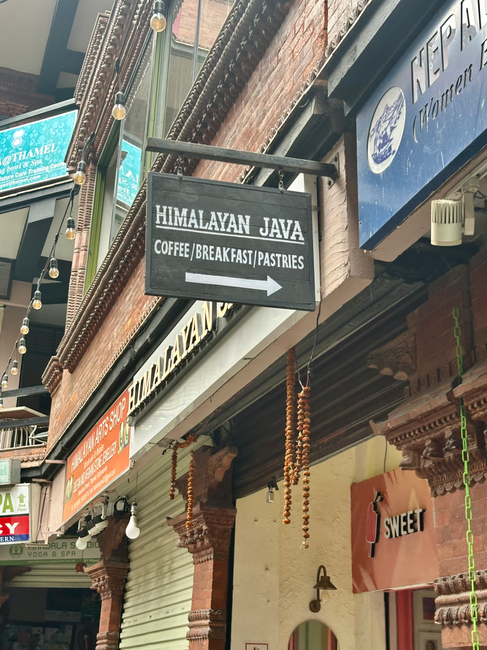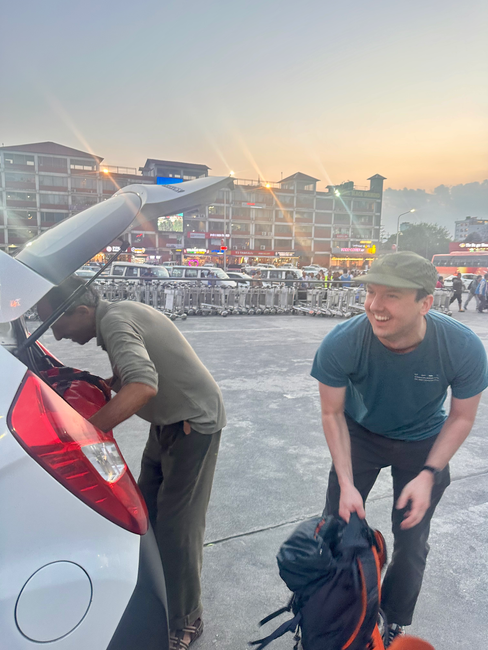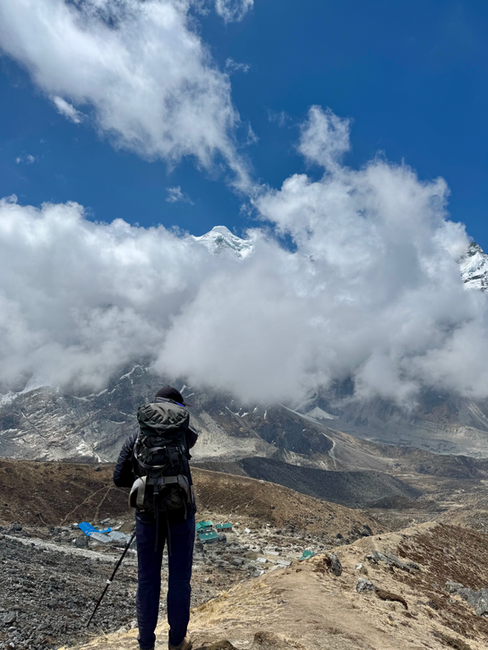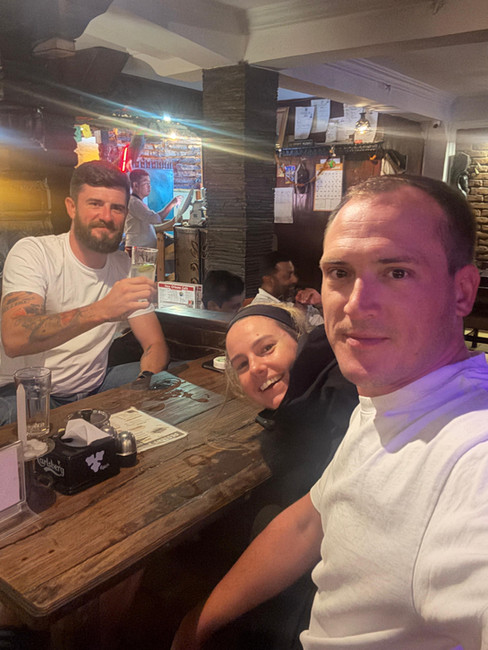Back to Nepal (Again)
- Holly

- Aug 17
- 7 min read
In late April I sat in a conference room on Boylston Street in Boston, at the conclusion of 7 consecutive interviews. My final interviewer broke the news that they’d be extending a job offer, and asked when I’d like to start. I pushed my luck, requesting a start date six weeks out. “Sounds great,” they replied. It was Nepal time!
I quit my job on a Monday morning, and shortly thereafter, booked the familiar Qatar Airways flight to Kathmandu through Doha, which departed in five hours time. I had assumed that my former employer would ask me to leave immediately (which they did), and preemptively packed my expedition gear.
My brother William is headed to business school this fall, and had the month of May off as well. In the weeks preceding my job offer, we had sensed that overlapping time off was likely on the horizon, and had formulated an expedition plan that we could execute on a moment’s notice. We’d climb Mera Peak, a 21,250ft mountain in Nepal, known for gentle terrain and a straightforward ascent. For those who have read my blogs on Cholatse and Gangchempo, it should be clear why my primary expedition criteria was gentle terrain and a straightforward ascent.
I arrived in Nepal a week before William, and after one night at the Yak and Yeti Hotel, took a jeep to the Langtang Valley for a five day solo trek. Langtang is the third most popular trekking region in Nepal, after the Everest and Annapurna regions, which I’ve trekked through extensively. I had never been to Langtang, and figured any extra days above sea level would be helpful for Mera Peak. Here’s a photo of Kyanjin Gompa, the final village in the Langtang Valley:

After the trek, I returned to Kathmandu to organize my climbing gear, arrange logistics for the Mera Peak expedition, and hangout in Himalayan Java Coffee:
A few days later, I met William at the airport, and we had an inaugural glass of wine in the Yak and Yeti lobby (one of my favorite pastimes):
We discussed our expedition plan, which I’d devised off a combination of internet research and pre-existing knowledge of Nepali mountain logistics. We would start in the village of Khote, from which we’d trek to Khare, the closest village to Mera, over five days. We’d meet our guides in Khare, and use the village as a “base camp,” resting and acclimatizing for four days before setting off on the two day summit push.
We departed Kathmandu by helicopter, stopping to refuel in the village of Lukla, which is the starting point of the trek to Everest Base Camp. We had arranged a porter to carry our mountaineering gear directly to Mera Peak, since we’d only need trekking gear for the first five days. The porter lived near Lukla, and we were told that we’d find him by the helipad on the refuel. The Lukla helipad is chaotic in peak climbing season, and without our porter’s contact (I don’t think he had a phone), or even his name, I had wondered how we’d locate him amidst the chaos. But he somehow appeared, hopped in the chopper, and off we went:

The Everest trail winds North, but we flew East to Khote, away from the well-trodden trekking route:
We landed at 7:45AM – plenty of time to trek onwards – but given Khote’s elevation of 11,800ft, we instead spent the first day acclimatizing (i.e. hanging out in the village doing absolutely nothing). Acclimatizing is only as fun as the people you’re with, so it was great to have William around for the company.
Elsewhere in Nepal, the villages host a mix of both trekkers and climbers tackling various routes and peaks. But on the trek to Mera, everyone shares a common climbing objective, which created a great sense of camaraderie in the villages. By evening, our lodge in Khote was full of ~25 climbers who had arrived sporadically throughout the day. Some climbers were ascending, others descending, and nearly every conversation started with “up or down?”
Our next destination was the village of Thangnak (14,300ft), which was a one day hike from Khote. We spent a full day acclimatizing in Thangnak as well. Some photos:
Next we trekked onwards to Khare (16,200ft), a village at the base of Mera Peak. There are two lodges in Khare, but most climbers were staying at Refuge Mera, where you can rent climbing gear (even skis!) and hire guides. More importantly, Refuge Mera serves Himalayan Java coffee:
Starting around noon, and continuing to early evening, a steady stream of exhausted climbers stumble into Refuge Mera from the summit (or sometimes lack thereof) and collapse in its infamous sunroom. By the last of our four days in Khare, we were well acquainted with nearly every climbing party, and it was highly entertaining to watch this phenomenon unfold. When not lounging in the sunroom, we took some nice day hikes above Khare:
By our fourth day in Khare we felt sufficiently acclimatized, which we announced to the staff of Refuge Mera, who arranged for guides to take us up the mountain the next day.
On the first day of the climb, we hiked for six hours to a High Camp at 19,000ft, which consisted of a handful of tents and a dining structure of sorts:
After an early dinner, we retreated to our tents and set our alarms for midnight. We’d start the climb at 1AM, hoping to summit at sunrise and be off the glacier by late-morning. I crawled in my sleeping bag, feeling optimistic despite a mild headache that I’d had all afternoon.
In 2023 I attempted to climb Spantik Peak (23,000ft) in Pakistan, but while laying in my tent on summit night, I developed altitude sickness. In the middle of the night, our Pakistani support climber dragged me down the mountain, while the rest of the team went up. The events of Spantik summit night have frustrated me ever since, and were one of the reasons we spent four days acclimatizing in Khare (instead of the standard two or three).
At Mera High Camp, my mild headache transformed into a major headache through the course of the evening. I lay awake all night, thinking to myself, “not again.” When my alarm went off at midnight, I put on my climbing gear and embarked on the six steps from my tent to the dining tent, which left me severely nauseous.
In the dining tent, William felt great and was making small talk with fellow climbers. We had followed an identical acclimatization regime, plus we share a significant amount of DNA, so I was selfishly frustrated by his capacity for small talk.
I wondered aloud if it was sensible to start the climb in my current state, to which William replied, “you should start and keep going until it doesn’t make sense anymore.” On that note, we started to climb, roped to two guides and moving particularly slowly:

We hiked for six hours, and I had a pounding headache and nausea for every minute of it. Ironically, my primary motivator was that I had no desire to ever do this again, and I knew that if I turned back, I’d inevitably rest a few days in Khare and try again.
Across the valley, we could see the headlamps of climbers summiting Everest – one of the coolest sights I’ve ever seen. Here’s a photo of Everest that I took in daylight on our descent:

Despite my altitude induced ailments, we reached the 21,250ft summit at 7AM:

From the summit, we descended back to High Camp, where I recorded an oxygen saturation of 66% (sub 95% lands you in a hospital in the U.S.). I felt validated in the extent to which I had struggled to reach the top. According to Gemini, I was amidst a medical emergency:

From High Camp, we hiked back to Khare, reaching Refuge Mera by mid-afternoon. I stumbled into the sunroom, which was full of familiar and welcoming faces.
We departed Khare the next morning, and in one long day, hiked back down the valley to our starting point of Khote. We were joined by Ollie and Callum, two friends from the British Special Forces whom we’d befriended in Khare, and a French backpacker who had been traveling for over a year. We each moved at our own pace, reconvening for coffee and food at various lodges along the way. It was one of the most memorable days I’ve had in Nepal, due to the solitude of walking down the valley alone, combined with the camaraderie of a shared group experience. In the last hour, Ollie decided to race William and record a lengthy play-by-play of his efforts for Instagram. Here’s a short clip:
Ollie, Callum, William and I had arranged for a helicopter to pick us up in Khote the next morning, but we awoke to a blanket of fog. We sent photos of the fog to our logistics agent in Kathmandu, and he passed them along to the airport in Lukla (our text exchange was the Nepali version of weather radar):

Eventually we heard the faint buzz of a helicopter, and sure enough, one emerged from a literal cloud:
According to our German pilot, these were not suitable flying conditions, so he joined us in the lodge for tea and a few additional hours of waiting. When a small opening appeared in the cloud, he hurried us into the chopper:
We stopped in Lukla to refuel, and William, Ollie, and Callum were ushered directly onto a chopper to Kathmandu. I had initially planned to stay in Lukla, rest for a day, and then potentially keep climbing or trekking. But as soon as they departed, I felt an overwhelming disillusionment with solo travel, so I went back to the helipad to return to Kathmandu myself.
After four hours at the Lukla helipad, I got a seat on a chopper to Kathmandu (the Lukla helipad is a cool place. I would happily have sat there for many more hours). My flight was technically a “rescue flight” for an Everest climber with frostbite, so we landed on the roof of the Kathmandu hospital. I’ve done a lot of odd things in Nepal, but this was a first:
In Kathmandu I checked back into the Yak & Yeti, and reunited with William. He had to leave the next day, but Ollie, Callum and I did tourist things for a few days:
I have a tendency to linger in Kathmandu, which is well documented elsewhere on the blog. This trip was no different, but eventually, it was time to leave. After one night in the the Doha airport hotel, and a 17-hour flight thereafter, I was back in San Francisco, with another great trip to Nepal in the books. Thanks for following!
































Love that the blog is back. Enjoyed every word. The summit night photos are truly spectacular!
The blog is back!! An excellent account of a great climb. Go Holly!